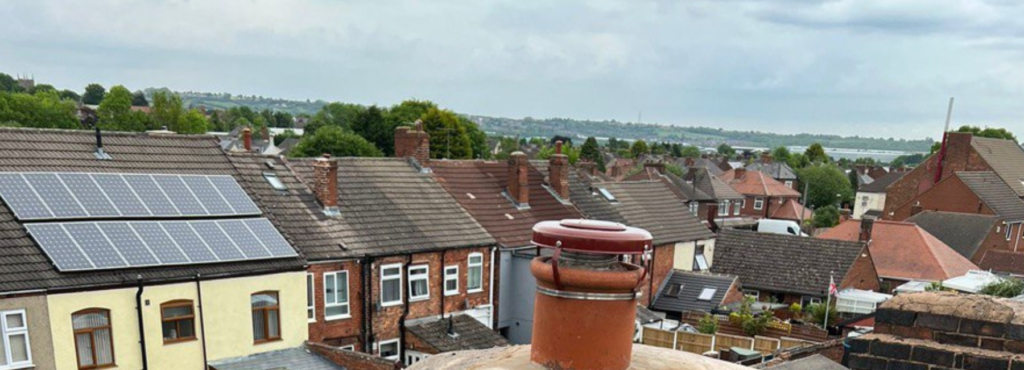Slate roofing is renowned for its durability, aesthetic appeal, and long lifespan. However, like any roofing material, slate tiles can become damaged over time due to various factors. Homeowners in Caterham, Surrey, should be aware of the common causes of slate tile breakage to ensure prompt repairs and long-term roof protection.
1. Weather Extremes
Heavy Rain and Storms
Slate tiles are designed to withstand harsh weather conditions, but prolonged exposure to heavy rain and storms can weaken them. Strong winds may also dislodge tiles or cause them to rub against each other, leading to cracks or chips.
Frost and Ice Damage
In colder months, water can seep into small cracks in the slate. When temperatures drop, the trapped moisture freezes and expands, causing the tile to crack. Over time, repeated freeze-thaw cycles can worsen the damage, leading to complete breakage.
Extreme Heat
While slate is highly resistant to heat, prolonged exposure to direct sunlight can cause expansion and contraction, which may lead to small fractures, particularly if the tiles are already compromised.
2. Poor Installation
Incorrect installation is a leading cause of premature slate tile breakage. Issues may include:
- Nails Driven Too Tightly – Over-tightened nails restrict natural movement and expansion, leading to stress fractures.
- Incorrect Overlapping – Poorly aligned slates can create pressure points, increasing the risk of breakage.
- Use of Inferior Fasteners – Non-corrosion-resistant nails may rust over time, weakening the structure and causing tiles to slip or crack.
3. Walking on the Roof
Unlike some roofing materials, slate is not designed to withstand direct foot traffic. Walking on slate tiles can:
- Cause immediate breakage due to their brittle nature.
- Lead to hairline fractures that worsen over time.
- Dislodge tiles from their fixed positions, making them more vulnerable to further damage.
Professional roofers use specialised equipment and techniques to navigate slate roofs without causing harm.
4. Falling Debris
Overhanging trees, strong winds, or accidental impact can result in falling branches, stones, or other debris striking the roof. This can lead to:
- Surface chipping, reducing the tile’s effectiveness.
- Structural cracks that allow moisture penetration.
- Complete breakage if the impact is severe.
Regular maintenance, including trimming nearby trees, helps prevent damage from falling debris.
5. Age-Related Deterioration
Slate is known for its longevity, with high-quality tiles lasting over a century. However, as the roof ages, natural wear and tear can cause:
- Flaking or Delamination – Layers of the slate start to peel away, weakening the tile.
- Reduced Structural Integrity – Over time, the slate becomes more fragile and susceptible to breakage.
Older roofs should be inspected regularly to identify and replace any weakened tiles before they fail completely.
6. Structural Movement
Buildings naturally settle over time, and slight movements in the structure can put stress on a slate roof. This can lead to:
- Misalignment of tiles, creating pressure points that increase the risk of breakage.
- Gaps that allow wind-driven rain to penetrate, leading to water damage.
- Loosening of fixings, making the tiles more susceptible to slipping or breaking.
A professional assessment can determine if structural movement is affecting the integrity of your slate roof.
7. Poor Quality Slate
Not all slate is created equal. Low-quality or improperly quarried slate may:
- Contain natural defects that make it more prone to cracking.
- Have inconsistent thickness, leading to uneven pressure distribution.
- Deteriorate faster than high-grade alternatives.
Investing in high-quality slate and professional installation ensures longevity and reduces the risk of premature breakage.
How to Prevent Slate Tile Damage
- Schedule Regular Inspections – Professional roof checks can identify and replace weak or cracked tiles before they worsen.
- Keep Gutters and Downpipes Clear – Blocked drainage systems can cause water to pool, increasing the risk of frost damage.
- Avoid Walking on the Roof – If repairs or maintenance are needed, always hire a roofing specialist with experience in slate roofing.
- Trim Overhanging Trees – Reducing the risk of falling branches can prevent unnecessary damage to your roof.
- Ensure Proper Installation – Hiring experienced roofers ensures correct fitting and long-lasting results.
Conclusion
Slate tiles are one of the most durable roofing materials available, but they are not indestructible. Understanding the common causes of slate tile breakage—such as weather conditions, poor installation, and structural movement—can help homeowners in Caterham, Surrey, take proactive steps to protect their roofs.
If you have noticed damaged or missing slate tiles, contact Caterham Roofing Repairs for expert assessment and professional repairs. Addressing issues early ensures your roof remains strong, weatherproof, and visually appealing for years to come.
Call us on: 01883 770 797
Click here to find out more about Caterham Roofing Repairs
Click here to complete our contact form and see how we can help with your roofing needs.

